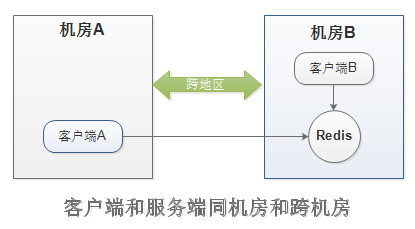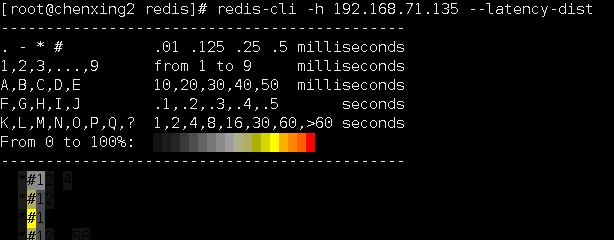| 命令 | 参数 | 功能 |
| redis-cli | -r | 将一个命令执行多次 |
| -i | 每隔几秒执行一次 | |
| -x | 和|一起接收前面地输出,并执行命令 | |
| -c | ||
| -a | ||
| --scan/--pattern | 扫描指定模式地键 | |
| --slave | 监控节点更新操作 | |
| --rdb | 实例生成并发送RDB持久化文件 | |
| --pipe | ||
| --bigkeys | 提取占用内存比较大的键 | |
| --eval | 执行Lua脚本 | |
| --latency | 检测网络延迟 | |
| --stat | 查看一些统计信息 | |
| --raw/--no-row | 可以返回原始格式 | |
| redis-benchmark | -c | 客户端并发数量 |
| -n <requests> | 客户端请求总量 | |
| -q | ||
| -r | 批量生成键 | |
| -p | ||
| -k | ||
| -t | ||
| --csv | 格式化输出 | |
| redis-server | --test-memory | 检查系统是否能提供指定内存 |
Redis提供了redis-cli、redis-server、redis-benchmark等shell工具,下面会分别介绍它们的用法。
在此之前我们先来回顾一下两种连接Redis服务器的方式。
第一种是交互式方式:通过redis-cli -h (host) -p (port)的方式连接到Redis服务,之后所有的操作都是通过交互的方式实现;
第二种是命令方式:用redis-cli -h (host) -p (port) {command}就可以直接得到命令的返回结果。
注意:如果没有指定IP和端口号,那么默认连接127.0.01和6379端口。
一、redis-cli详解
之前曾经简单的介绍过了redis-cli,包括-p、-h参数,但是除了这些参数,还有许多有用的参数,在某些情况下非常有用。
如果要了解redis-cli的全部参数,可以执行redis-cli -help命令来进行查看,下面介绍部分常用的。

Usage: redis-cli [OPTIONS] [cmd [arg [arg ...]]] -h <hostname> Server hostname (default: 127.0.0.1). -p <port> Server port (default: 6379). -s <socket> Server socket (overrides hostname and port). -a <password> Password to use when connecting to the server. -r <repeat> Execute specified command N times. -i <interval> When -r is used, waits <interval> seconds per command. It is possible to specify sub-second times like -i 0.1. -n <db> Database number. -x Read last argument from STDIN. -d <delimiter> Multi-bulk delimiter in for raw formatting (default: ). -c Enable cluster mode (follow -ASK and -MOVED redirections). --raw Use raw formatting for replies (default when STDOUT is not a tty). --no-raw Force formatted output even when STDOUT is not a tty. --csv Output in CSV format. --stat Print rolling stats about server: mem, clients, ... --latency Enter a special mode continuously sampling latency. --latency-history Like --latency but tracking latency changes over time. Default time interval is 15 sec. Change it using -i. --latency-dist Shows latency as a spectrum, requires xterm 256 colors. Default time interval is 1 sec. Change it using -i. --lru-test <keys> Simulate a cache workload with an 80-20 distribution. --slave Simulate a slave showing commands received from the master. --rdb <filename> Transfer an RDB dump from remote server to local file. --pipe Transfer raw Redis protocol from stdin to server. --pipe-timeout <n> In --pipe mode, abort with error if after sending all data. no reply is received within <n> seconds. Default timeout: 30. Use 0 to wait forever. --bigkeys Sample Redis keys looking for big keys. --scan List all keys using the SCAN command. --pattern <pat> Useful with --scan to specify a SCAN pattern. --intrinsic-latency <sec> Run a test to measure intrinsic system latency. The test will run for the specified amount of seconds. --eval <file> Send an EVAL command using the Lua script at <file>. --help Output this help and exit. --version Output version and exit.
1.-r
-r(repeat)选项代表将命令执行多次。
[root@Redis ~]# redis-cli -r 3 ping
PONG
PONG
PONG
2.-i
-i(interval)选项代表每隔几秒执行一次命令,但是-i选项必须和-r选项一起使用。
[root@Redis ~]# date;redis-cli -r 3 -i 2 ping;date
2017年 12月 22日 星期五 23:56:39 CST
PONG
PONG
PONG
2017年 12月 22日 星期五 23:56:45 CST
#时间间隔是6秒
注意-i的单位是秒,不支持毫秒为单位,但如果想每隔10毫秒执行一次,可以使用-i 0.01。
3.-x
-x选项代表从标准输入(stdin)读取数据作为redis-cli的最后一个参数,一般与管道符在一起使用。
[root@Redis ~]# echo dbsize|redis-cli -x
(integer) 14
4.-c
-c(cluster)选项是连接Redis Cluster节点时需要使用的,-c选项可以防止moved和ask异常,后面会详细讲解。
5.-a
如果Redis配置了密码,可以使用-a(auth)选项,有了这个选项就不需要手动输入auth命令。
6.--scan和--pattern
--scan选项和--pettern选项用于扫描指定模式的键,相当于使用scan命令。
7.--slave
--slave选项是把当前客户端模拟成当前Redis节点的从节点,可以用来获取当前Redis节点的更新操作,
合理的利用这个选项可以记录当前连接Redis节点的更新操作,这些更新操作可能是实际开发业务时需要的数据。
第一个客户端使用--slave选项,可以看到它会一直处于等待状态:
[root@Redis ~]# redis-cli --slave SYNC with master, discarding 1765 bytes of bulk transfer... SYNC done. Logging commands from master. "PING"
另外一些客户端进行一些数据的操作:
127.0.0.1:6379> set zj sb OK 127.0.0.1:6379> del zj (integer) 1
设置--slave选项的客户端会出现这些操作的指示:
[root@Redis ~]# redis-cli --slave SYNC with master, discarding 1765 bytes of bulk transfer... SYNC done. Logging commands from master. "PING" "PING" "PING" "PING" "PING" "SELECT","0" "set","zj","sb" "PING" "PING" "del","zj"
8.--rdb
--rdb选项会请求Redis实例生成并发送RDB持久化文件,保存在本地,可以使用它做持久化文件的定期备份。
9.--pipe
--pipe选项用于将命令封装成Redis通信协议定义的数据格式,批量发送给Redis执行。
10.--bigkeys
--bigkeys选项使用scan命令对redis的键进行采样,从中找到内存占用比较大的键值,这些键可能是系统的瓶颈。
11.--eval
--eval选项用于执行指定的Lua脚本。
12.--latency
latency有三个选项,分别是--latency、--latency-history、--latency-dist。它们都可以检测网络延迟,对Redis开发和运维非常有帮助。
(1)--latency
该选项可以测试客户端到目标Redis的网络延迟。
例如如下拓扑结构:

机房A和B是跨地区,客户端B可以直接访问Redis服务器。
客户端B的网络延迟:
[root@Redis ~]# redis-cli --latency min: 0, max: 1, avg: 0.07 (824 samples)
客户端A的网络延迟:
[root@chenxing2 redis]# redis-cli -h 192.168.71.135 --latency min: 0, max: 1, avg: 0.33 (113 samples)
可以看到客户端A由于距离Redis比较远,平均的网络延时会高一些。
(2)--latency--history
--latency1的执行结果只有一条,如果想以分时段的形式了解延迟信息,可以使用--latency-history选项
[root@chenxing2 redis]# redis-cli -h 192.168.71.135 --latency-history min: 0, max: 2, avg: 0.31 (1357 samples) -- 15.01 seconds range min: 0, max: 2, avg: 0.35 (1355 samples) -- 15.00 seconds range min: 0, max: 2, avg: 0.38 (1354 samples) -- 15.00 seconds range
可以看到延时信息每15秒输出一次,可以通过-i参数控制间隔信息。
[root@chenxing2 redis]# redis-cli -h 192.168.71.135 -r 3 -i 1 --latency-history min: 0, max: 1, avg: 0.27 (92 samples) -- 1.00 seconds range min: 0, max: 1, avg: 0.23 (91 samples) -- 1.00 seconds range
(3)--latency-dist
该选项会使用图表的形式从控制台输出延迟统计信息。

13.--stat
--stat选项可以实时获取Redis的重要统计信息,虽然info命令中的统计信息更全,但是能实时看到一些增量的数据(例如requests)对于Redis的运维还是有帮助的。
[root@chenxing2 redis]# redis-cli --stat ------- data ------ --------------------- load -------------------- - child - keys mem clients blocked requests connections 0 862.15K 1 0 0 (+0) 2 0 862.15K 1 0 1 (+0) 2 0 862.15K 1 0 2 (+1) 2 ......
14.--raw和--no-raw
--no-raw选项是要求命令的返回结果必须是原始的格式,--raw恰恰相反,返回格式化后的结果。
在Redis中设置一个键,如果用get或--no-row选项,那么返回的结果是二进制格式:
[root@Redis ~]# redis-cli set hello "你好" OK [root@Redis ~]# redis-cli get hello "xe4xbdxa0xe5xa5xbd" [root@Redis ~]# redis-cli --no-raw get hello "xe4xbdxa0xe5xa5xbd"
如果使用--raw选项,就会返回中文:
[root@Redis ~]# redis-cli --raw get hello 你好
二、redis-benchmark
redis-benchmark可以为Redis做基准性能测试,它提供了很多选项帮助开发和运维人员测试Redis的相关属性。
1.-c
-c(clients)选项代表客户端的并发数量
2.-n <requests>
-n(num)选项代表客户端请求总量(默认是10000)。
例如redis-benchmark -c 100 -n 20000代表100个客户端同时请求Redis,一共执行20000次。
redis-benchmark会对各类数据结构的命令进行测试,并给出性能指标:
====== GET ====== 20000 requests completed in 0.17 seconds 100 parallel clients 3 bytes payload keep alive: 1 95.92% <= 1 milliseconds 99.75% <= 2 milliseconds 100.00% <= 2 milliseconds 116959.06 requests per second
例如上面一共执行了20000次操作,在0.17秒完成,每个请求是3个字节,95.92%的命令执行时间小于1毫秒,Redis每秒可以处理116959.06次get请求。
-3.-q
-q选项仅仅显示redis-benchmark的requests per second1信息:
[root@Redis ~]# redis-benchmark -c 100 -n 20000 -q PING_INLINE: 113636.37 requests per second PING_BULK: 121951.22 requests per second SET: 115606.94 requests per second GET: 118343.20 requests per second INCR: 116959.06 requests per second LPUSH: 113636.37 requests per second LPOP: 113636.37 requests per second SADD: 114285.72 requests per second SPOP: 108695.65 requests per second LPUSH (needed to benchmark LRANGE): 104166.66 requests per second LRANGE_100 (first 100 elements): 46403.71 requests per second LRANGE_300 (first 300 elements): 19940.18 requests per second LRANGE_500 (first 450 elements): 11750.88 requests per second LRANGE_600 (first 600 elements): 11117.29 requests per second MSET (10 keys): 85470.09 requests per second
4.-r
一个空的Redis上执行了redis-benchmark会发现只有三个键:
[root@chenxing2 redis]# redis-benchmark -c 100 -n 20000 -q PING_INLINE: 82644.62 requests per second PING_BULK: 96618.36 requests per second SET: 98522.17 requests per second GET: 93896.71 requests per second INCR: 93023.26 requests per second LPUSH: 100000.00 requests per second LPOP: 102564.11 requests per second SADD: 104166.66 requests per second SPOP: 99502.48 requests per second LPUSH (needed to benchmark LRANGE): 105263.16 requests per second LRANGE_100 (first 100 elements): 37950.66 requests per second LRANGE_300 (first 300 elements): 17873.10 requests per second LRANGE_500 (first 450 elements): 12961.76 requests per second LRANGE_600 (first 600 elements): 10256.41 requests per second MSET (10 keys): 39840.64 requests per second [root@chenxing2 redis]# redis-cli 127.0.0.1:6379> dbsize (integer) 3 127.0.0.1:6379> keys * 1) "key:__rand_int__" 2) "counter:__rand_int__" 3) "mylist"
如果想向Redis插入更多的键,可以执行使用-r(random)选项,可以向Redis插入更多的随机键。
[root@chenxing2 redis]# redis-benchmark -c 100 -n 20000 -r 10000
-r选项会在key、counter键上加一个12位的后缀,-r 10000代表只对后四位做随机处理(-r不是随机数的个数),
例如上面操作后,key的数量和结果结构如下:
127.0.0.1:6379> dbsize (integer) 18656 127.0.0.1:6379> scan 0 1) "5120" 2) 1) "counter:000000002683" 2) "key:000000008908" 3) "counter:000000005887" 4) "counter:000000008039" 5) "key:000000001037" 6) "key:000000004592" 7) "counter:000000003728" 8) "counter:000000009443" 9) "counter:000000000413" 10) "key:000000009427"
5.-p
-p选项代表每个请求pipline的数据量(默认位1).
6.-k <boolean>
-k选项代表客户端是否使用keepalive,1为使用,0为不使用,默认值为1.
7.-t
-t选项可以对指定进行基准测试
[root@chenxing2 redis]# redis-benchmark -t get,set -q SET: 96246.39 requests per second GET: 106951.88 requests per second
8.--csv
--csv选项会将结果按照CSV格式输出,便于后续处理,如导出到Execl等。
[root@chenxing2 redis]# redis-benchmark -t get,set -q --csv "SET","101010.10" "GET","106837.61"
三、redis-server
redis-server除了启动Redis外,还有一个--test-memory选项。
redis-server --test-memory可以用来检测当前操作系统能否稳定地分配指定容量地内存给Redis,通过这种检测可以有效避免因为内存问题造成Redis崩溃。
